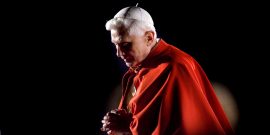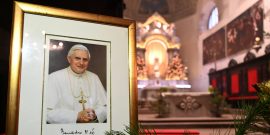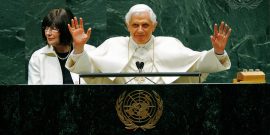Benedict always spoke of a “reason illumined by faith,” a dialogue that he believed characterized Europe at its best.
A Prophet of Our Time
At 93 years, he has become physically frail, weak, and barely audible. Life at Mater Ecclesiae consists of daily Mass, walks in the Vatican gardens, and prayer. This peaceful setting starkly contrasts the noisy world that has often misunderstood and misrepresented his ideas and life. Nonetheless, the first Pope Emeritus since Celestine V in the 13th century has a clear mind that is patiently waiting, not for death, but rather eternal life.
Joseph Ratzinger is a thinker who everyone—regardless of Catholic or not—must admire for his intellect. There is little doubt that Ratzinger—and later Pope Benedict XVI—is one of the most influential thinkers of the 20th century. With Benedict XVI: A Life, Peter Seewald, a German journalist who has interviewed the Pope in several books and is one of the foremost authorities on Ratzinger, has put forward an authoritative biography of his hero. The first volume of two has now been published in English (with the second reportedly slated to be published in fall), already standing at 512 pages. The German version, published in early 2020 in one volume (and which is the subject of this review), consists of 1,100 pages, and explains Ratzinger’s eventful life in great detail.
Ratzinger was born in Marktl am Inn, a small village close to the popular pilgrimage town Altötting, on Holy Saturday of 1927. Almost everyone in southern Germany was Catholic then, and Catholicism seeped into every local tradition, festival, and societal life at large. In this world encompassed by faith, children did not dream of becoming soccer stars, but priests and nuns. Instead of Christmas toys, they looked forward to unwrapping their first missals or Bibles which they used in “practicing mass” at home. This world, one of Church, rural life, and the Bavarian Alps, is the world that formed Ratzinger’s childhood and of which he dreamt of throughout his life.
Much of that beauty would soon be destroyed. As Germany succumbed to the evil of Nazism, most Catholics found themselves in a bind on whether to support Hitler’s regime. Most didn’t—including the Church itself—and the Ratzinger family certainly didn’t either. Indeed, the family moved several times to ever more rural areas to avoid the looming observation of the Nazi authorities. The regime progressively clamped down on religious activities. Later on, both Joseph and his brother Georg were drafted into the war effort, though Joseph escaped the great battlefields. Nonetheless, the evil of fascism would influence his thinking for the rest of his life, ever traumatized by revolutions and by totalitarian plans to completely remake society top-down and to silence speech and religion.
After World War II, Ratzinger’s most formative years in theology were spent studying in Freising and Munich, where professors took note of his intellectual and theological brilliance and his eloquent, colorful, and moving language in articulating his arguments, a trait that would follow him throughout his life. Most importantly, in these early years Ratzinger developed two major themes of his future works: the Church as the “Mystical Body of Christ” inspired by St. Augustine, and a focus on eschatology, inspired by St. Bonaventura. The latter theme emphasizes the need for modern man, who had become too absorbed in material and earthly pleasures while terrified of thinking about the inevitability of death, to refocus on the transcendental and eternal life.
Ratzinger quickly rose to theological stardom in Germany. His high point in his life as an intellectual—the life he always had wanted and cherished the most—came as a consultant to Cardinal Frings of Cologne at the Second Vatican Council.
For Ratzinger, the years after World War II had become a disillusioning sight for German Catholicism. Germans simply didn’t seem to be actively Catholic anymore. They had lost knowledge about what they believed in and, thereby, lost touch with the Church. Ratzinger was so disheartened that he warned of the New Pagans from within.Before Vatican II, he made two key observations: first, that there was a very real possibility that Christianity would become a minority position in the modern world. And second, that the Church was in urgent need of reform to face this reality. It should reinvent itself—by going back to the basics of the faith and studying the early Church fathers. Only by being able to proudly proclaim the unchanged and traditional faith in new ways would Catholics be able to sustain the Church in a liberal world.
Ratzinger’s role during the Council has been subject to much debate. For liberal, reformist voices like Hans Küng, Ratzinger was one of theirs—until he betrayed them in the years after the Council. Traditionalists would agree with them, saying that Ratzinger was too liberal during the Council and that he would become more traditional later in life as he came to realize and regret what abysmal processes he and his zealous young colleagues had caused. Admirers of Ratzinger and proponents of Vatican II have instead held that Ratzinger didn’t change his opinions, but that the Council was falsely interpreted. Consequently, it became Ratzinger’s life-long task to promote the correct interpretation of the Council: a statement of human freedom and dignity, a reconciliation with liberalism, and an opening of the Church to the world, by going out into the world with “joy and hope,” not a pandering to modernists and a secularization of the Church.
Despite a remarkable number of former students and professors recounting that Ratzinger was a liberal, even a “leftist”, before the Council, Seewald takes the view that neither Ratzinger, nor the Council were originally liberal to the extent it has been portrayed by many since. It is clear that Ratzinger at least became increasingly disillusioned as the Council came to an end, surmising that it would be misinterpreted. Thus, Ratzinger—next to fellow Councilmen like Wojtyla, Balthasar, and de Lubac—became a warning voice to stick to what the Council documents said as opposed to using them as an opportunity to weed out the Church of every tradition, which many others, particularly in Germany, have done to this day.
What this biography makes abundantly clear is that Pope Benedict XVI is certainly a figure worth studying.
It is telling for us in today’s world that Ratzinger never wavered in his belief that the Council was the right path, that religion could revitalize itself in a bottom-up process—after some hard times—in a modern world that had lost touch with God. Ratzinger has also consistently held that Catholicism could live with liberalism, and that as long as liberalism honors its Judeo-Christian principles, liberalism would be a boon to both human freedom and dignity as well as the Church. Pope Benedict never abandoned his position in favor of ultra-traditionalism, gave up Vatican II’s teachings, or misrepresented the views of various liberal thinkers the way they often twisted his own words.
When Ratzinger was a professor in Regensburg from 1969 to 1977, he thought that he could, for the rest of his life, stay in Pentling, a small town close-by where he bought his own house, and simply teach and write. Instead, he became the new Archbishop of Munich in 1977, and was then ordered to Rome in 1981 by his friend Wojtyla to become the head of the Congregation for the Doctrine of the Faith. As becomes evident again and again in Seewald’s biography, Ratzinger would have preferred to live a contemplative life in Bavaria. God had different plans. The recent and popular Netflix movie The Two Popes ignores this, instead portraying Pope Benedict as a man addicted to power. This as much as anything else has promoted a false image of Ratzinger.
As the Prefect of the Congregation, Ratzinger defended the Church’s teaching from liturgical abuse and false theories of faith like liberation theology. His and John Paul II‘s devoted friendship for over a quarter century made them an inseparable duo. Ratzinger asked Wojtyla to replace him with someone else on several occasions—each time the Pope wanted him to stay. When his friend died in 2005, Ratzinger planned to finally head back home—the flight tickets were already booked, never to be used: on April 19, 2005, he became the new Pope.
In his eight-year papacy, Papa Benedetto continued his intellectual work, with his magnum opus, his Jesus trilogy, refocusing the Catholic faith on its figurehead: Jesus Christ. It was not only that Jesus loves us, but that “God is Love” was the maxim that Pope Benedict brought to light in the eyes of millions. This love, this agape that we should all strive for in life after Christ’s example, was at the center of the first of his three encyclicals Deus Caritas Est.
In one of the most unexpectedly controversial moments of his papacy—the Regensburg address in 2006—he continued warning that the modern world was slithering into a “dictatorship of relativism.” Only a reconciliation of faith and reason – which are not opposed but in need of one another—and a reorientation to the Logos, an idea that had dominated Western civilization for millennia, from the Israelites and Ancient Greek philosophers to today’s Christians, would avoid disaster. He cautioned European political leaders not to forget this Western heritage, that the future of Europe needs to be based on Christian principles, on the defense of life from conception to death, and a commitment to human freedom and free will.
Seewald’s biography has, naturally, many stories of all these periods of Ratzinger’s life, including a new ten-page interview with the Pope in which he announces that he has prepared a final testament to the world which will be released after his death.
The book sadly suffers from problems without which the long read would have been more enjoyable. Too often, Seewald goes off-topic: during Ratzinger’s children years, there are several sections in which Ratzinger isn’t even mentioned. For example, Seewald wanders from the subject of his book into overly detailed explanations for World War II. The chapters on the Second Vatican Council are extremely interesting and well written, but suffer from constant digressions on simultaneous events around the world. These digressions add little more than disruptions to the narrative.
The worst case of this comes in the second half of the book—or what will be the second forthcoming volume in English—in which Seewald frequently goes off on tangents of the unfair treatment of Ratzinger in the German media, listing one sensationalist media headline after another, often for several pages. That the newspapers Der Spiegel and Süddeutsche Zeitung feature prominently here—two newspapers Seewald worked for in the past—makes these passages seem more like a personal vendetta. Once more, Ratzinger vanishes at times. These distracting passages give the reader the feeling that the book could be hundreds of pages shorter without sacrificing information about its protagonist.
But this is not to say that the book isn’t well written, mostly engaging, informative, and may go down as the authoritative biography of Pope Benedict. All of this is true. Where the biography is focused on its true subject, the life of Ratzinger, it is an excellent and intriguing read.
What this biography makes abundantly clear is that Pope Benedict XVI is certainly a figure worth studying. Joseph Ratzinger is one of the defining personalities of the 20th century, one of the most influential Churchmen in Catholic history, and as we look back at him and the times he lived through—the Bavarian rural lands, the evil of fascism, the post-war sexual revolution, the evil of communism through his work with John Paul II, and the crises of modern society—we might see him as a prophet of our time. He challenges our perceptions of ourselves and the world. And he is undoubtedly a successful defender of the faith.
And considering his work spans over all areas of life beyond the Church, it is also not just enjoyable for Catholics to engage with him. Anyone who cherishes and admires, like Pope Benedict, the good, the true, and the beautiful, should start engaging with Joseph Ratzinger’s work.



